NMR Probes
Many NMR probes are available. A selection is shown below.
300 MHz NMR Probes
Several probes are available for the 300 MHz wide-bore NMR instrument.
-
TBI 300 MHz WS1 5 mm with z-gradient four-channel solution-state probe
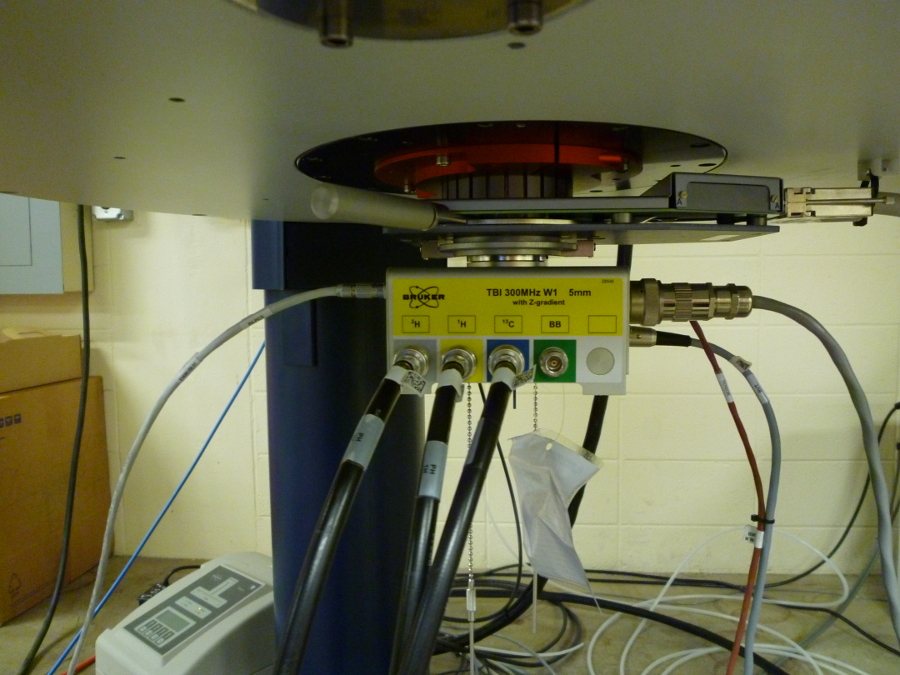
With this probe, It is possible to observe a wide range of nuclei, ranging from high sensitivity observation of proton, carbon, phosphorous, and fluorine to allowing observation of a large number of more exotic nuclei. It is capable of performing most modern liquid phase NMR experiments including state of the art two- and three-dimensional experiments with pulsed field gradients. It is available to departmental users to solve structural problems requiring high resolution capabilities.
-
HRMAS 300 MHz W1S2 4 mm solid-state probe
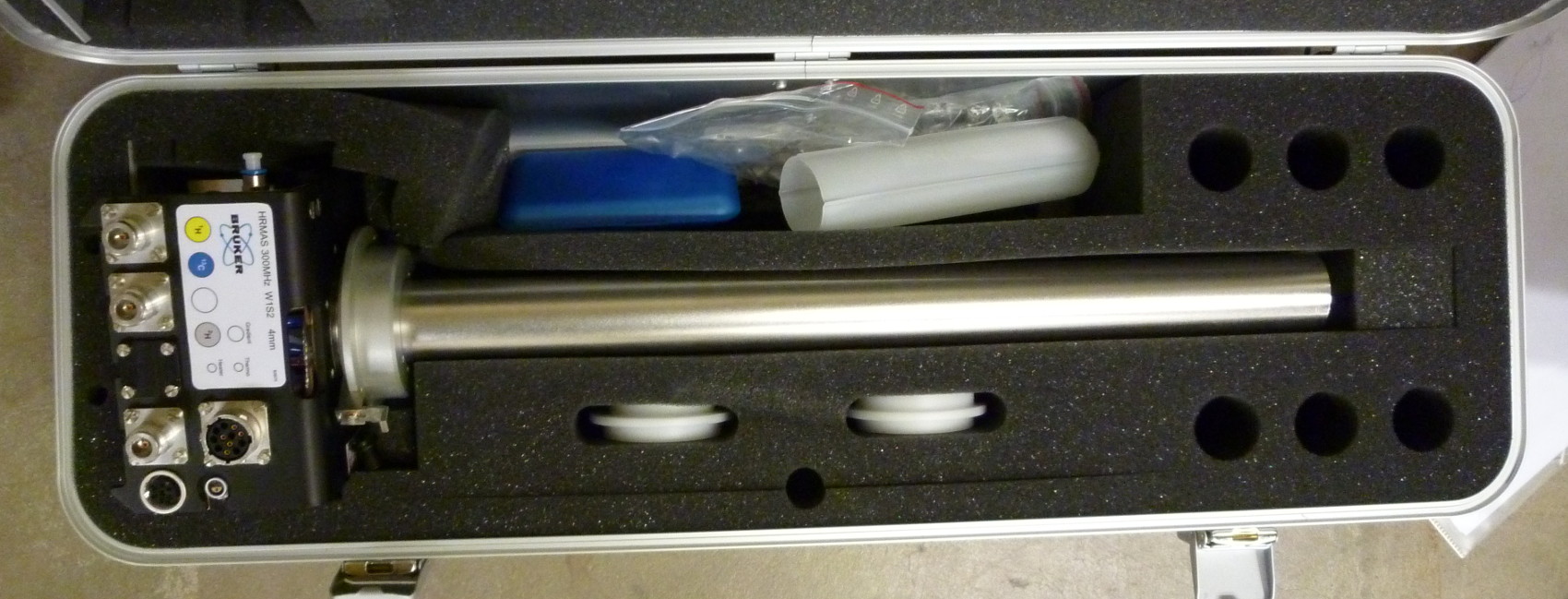
-
Diffusion and rheo-NMR probe
MIC 300 MHhz W1/S2 DIFF/50 diffusion probe
This is a dedicated high power gradient diffusion probe that are the ultimate tools to deliver resolution in DOSY and in q-space experiments. High gradient strength and fast switching times enable diffusion investigation at short diffusion times, thus allowing the detection of various diffusion times over a wide range. High gradient strength is essential for the investigation of X-Nuclei. Rheological-NMR deals with NMR for substances in the interface between solid and liquid phases such as polymer melts and solutions, lyotropic and thermotropic liquid crystals, micellar surfactant phases, colloidal suspensions and emulsions. Most biological fluids, most food materials and many fluids important in industrial processing or engineering applications exhibits such complexity. Rheo-NMR has been able to provide a direct window on a variety of behaviour, including slip, shear-thinning, shear banding, yield stress behaviour, nematic director alignment and shear-induced meosphase reorganisation. Very few research groups around the world utilize rheological NMR.
gradient strength = 50 (G/cm) A => maximum gradient strength = 30 T/m at 60 A
Theoretical gradient sensitivity = 0.5 T / m / A
Typical gradient strength at 60 A > 28.5 T / m
There are two gradient coils available:
DIFF50 HP GRADIENT
GRAD SYSTEM MICRO 5
The first coil, DIFF50, can manage a gradient strength of 50 G / cm / A, whereas the MICRO 5 gradient coil a gradient strength of about a tenth: 4.8 G / cm / A.
The MICRO 5 probe is typically used to study mineral or geological samples, polymers, tablet dissolution kinetics, plants and seeds, bone, or tissue biopsy samples, and small insects. It can be used for standard bore magnets.
The following inserts are available for this probe (the inserts hold the sample):
1H 5 mm, 1H 8 mm, 1H 10 mm, 13C-1H 5 mm, 13C-1H 8 mm
Available is also:
Micro2.5 - MICWB40 System
This system consists of a Micro2.5 probe and exchangeable inserts. This system only fits into wide bore magnets ( 89 mm) or larger. We have a 89 mm wide bore magnet. The gradient coil and the MICWB40 radio frequency part are separate: The gradient coil is mounted separately the magnet by means of a separate holder. The gradient coils are water cooled. They remain the magnet during probe/sample exchange. The maximum gradient current is 60 A and the maximum gradient strength is 1.5 T/m = 150 G /cm @ 60 A. (2.5 G / (cm* A).
As for the separate radio frequency units, four imaging coils are available that make it possible to image a wide range of samples, such as rock samples, plants, and animals.
-
Bruker MICWB40 RES 300 1H/13C 040/005 LLTR
-
Bruker MICWB40 RES 300 1H 040/010 LTR
-
Bruker MICWB40 RES 300 1H 040/015 LTR
-
Bruker MICB40 RES 300 1H 040/025 QTR
The above pictures shows the imaging probe and three imaging coils. The other one, 040/015 LTR looks very similar and has a special glass insert (not shown).
There is a difference between the linearly polarized and the circularly polarized coils. For linearly polarized transmission coils (LTR) for MRI, both transmission and reception of electromagnetic radiation takes place along a single axis. They are inefficient as half their power is wasted, as any linearly oscillating field can be decomposed into 2 counter-rotating circular fields, one in the direction and frequency as the NMR spin system and the other in the opposite direction. The oppositely rotating field does not affect the spin system and just leads to sample heating, Circularly polarized field can be generated by adding a second set coils perpendicular to the first and driving them with sinusoidal current phase shifted by 90 Degrees, called quadrature transmission (QTR). The unwanted counter-rotating fields from each linear coil sets are always 180 Degrees out of phase and hence cancel eath other. Thus, heating of the sample is minimized, only half the radiofrequency energy needs to be used, and a better signal-to-noise ratio for the received signals is achieved.
The imaging coils cover sample sizes of 5 mm, 10 mm, 15mm, 25 mm that can be imaged. It is possible to insert larger samples than that into the non-imaged portion of the assembly, to accommodate animals, for example. The diameter of the assembly is 40 mm.
400 MHz NMR Probes
The 400 MHz instrument is capable of analyzing liquid samples in a variety of experiments.
Three NMR probes are available for this instrument.
-
5 mm BBinv x,y,z gradient
-
5 mm BBO
-
The 5.0 mm multi-nuclear observe probe with Z-gradient is used for a broad variety of experiments. It is the most frequently used probe for this instrument. It is possible to do simultaneous 1H and 19F detection. The broadband channel can be tuned to a wide range of nuclei, e.g., 19F, 13C, 31P.
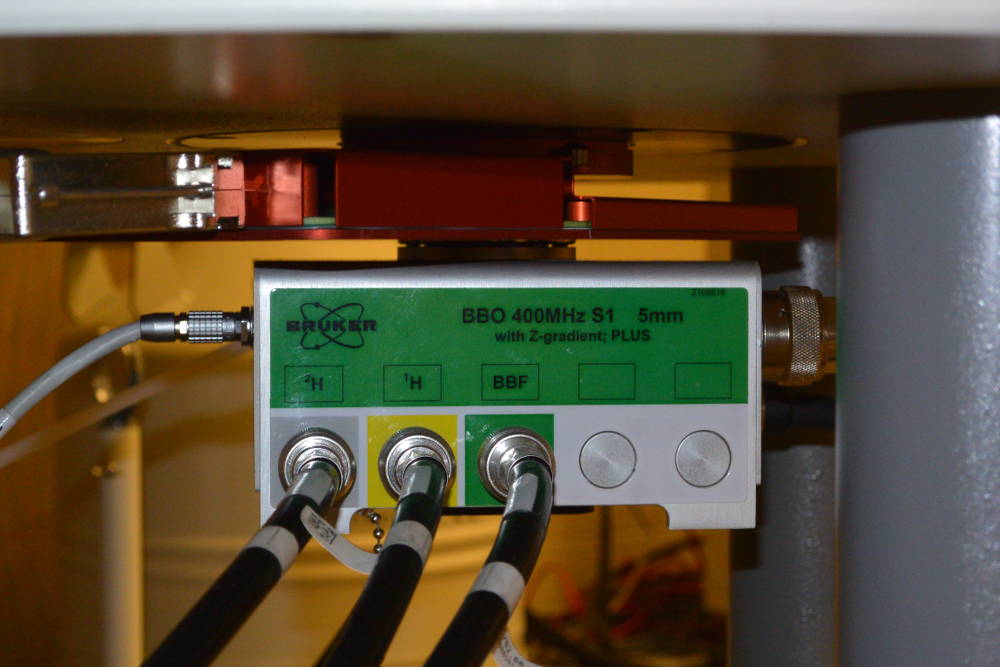
600 MHz NMR Probes
The 600 MHz instrument is capable of analyzing both solid and liquid samples in a
variety of experiments.
-
The 5.0 mm multi-nuclear broad band observe probe is used in a broad variety of experiments including 1H observe with 19F decoupling and the observation of exotic nuclei such as 195Pt.
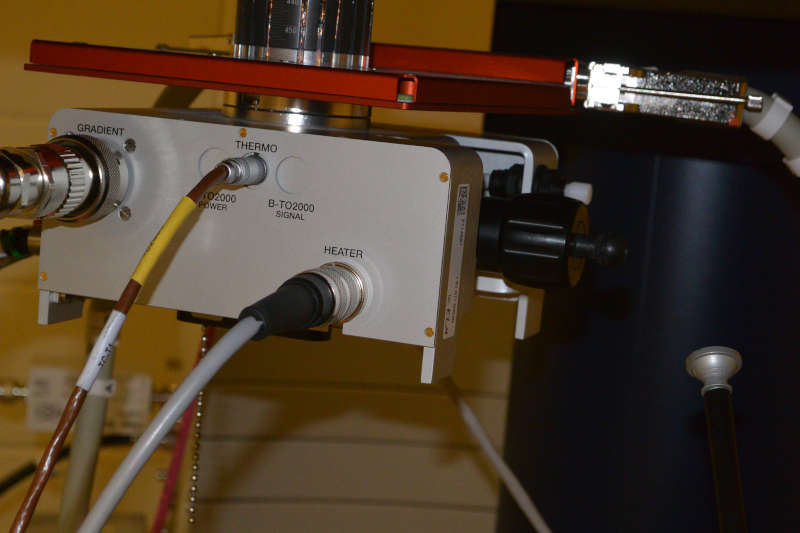
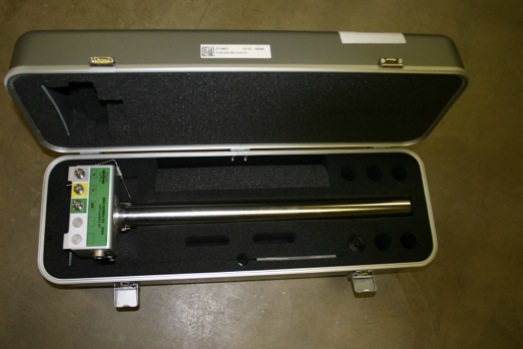
- The 1.7 mm triple resonance inverse (TXI) probe (1H, 13C, 15N) is used for experiments where only small amounts of organic or biological samples are available.
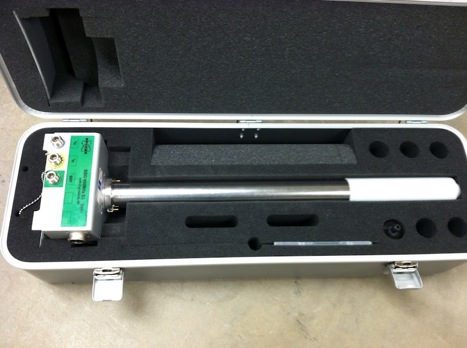
- The 4.0 mm triple resonance (1H, 13C, 15N) E-free CPMAS Bio-solids probe is used for experiments on solid biological samples.
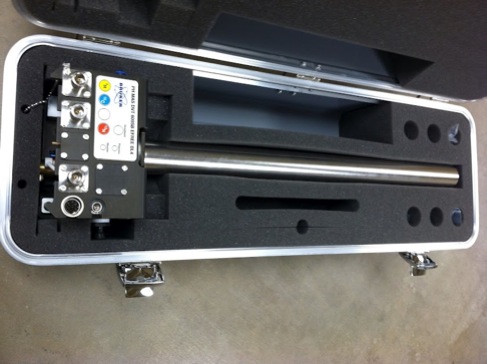
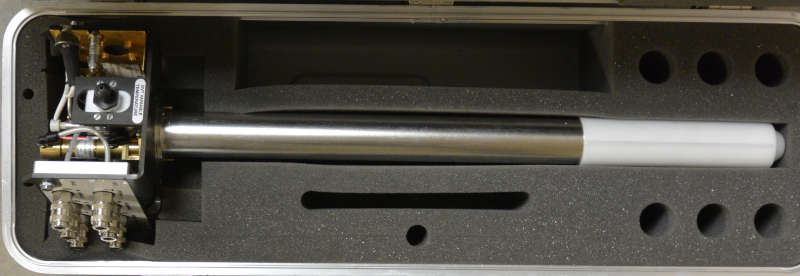
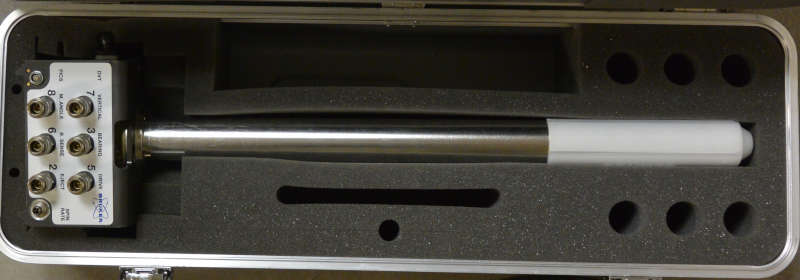
Anasazi Eft-60 NMR Probes
There is one probe available for the Anasazi Eft-60 that allows detection 1H and 13C. In particular the 13C detection is pretty good and quite useful. This is crucial as the natural abundance of 13C is very low (about 1.109%) that usually makes 13C-NMR quite time-consuming. In fact, many NMR spectrometers below 100 MHz proton frequency do not even offer 13C-detection.
The instrument allows operation in 1 and 2 dimensions (1D and 2D).
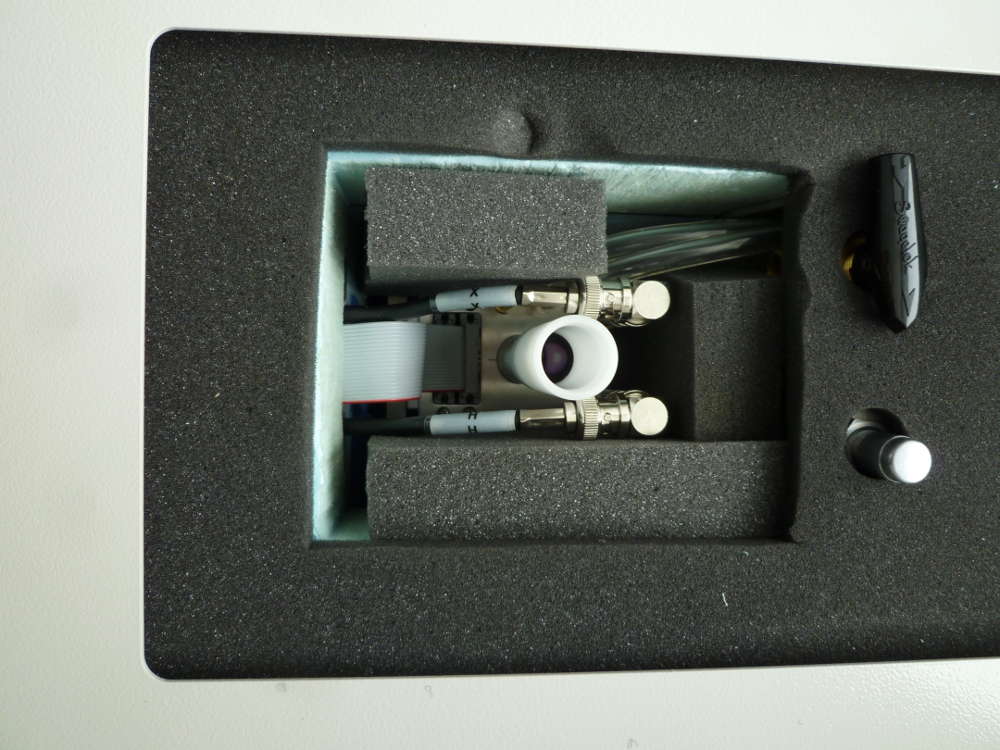
Page created by Alexander Goroncy.

